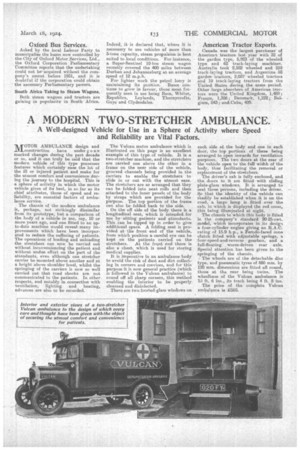A MODERN TWO-STRETCHER AMBULANCE.
Page 9

If you've noticed an error in this article please click here to report it so we can fix it.
A Well-designed Vehicle for Use in a Sphere of Activity where Speed and Reliability are Vital Factors.
ATOTOR AMBULANCE design and .111.construction have under g o n-e marked changes during the past decade or so, and it can truly be said that the modern vehicle of this type possesses features which certainly ease the lot of the ill or injured patient and make for the utmost comfort and convenience during the journey to the hospital. This is a sphere of activity in which the motor vehicle gives of its best, in so far as its chief attributes, those of speed and reliability, are essential factors of ambulance service.
The chassis of the modern ambulance is, perhaps, not strikingly dissimilar from its prototype, but a comparison of the body of a vehicle in use, say, 10 or more years ago, and one fitted to an upto-date machine would reveal many improvements which have been incorporated to reduce the suffering of patients. The operations of loading and unloading the stretchers can now be carried out without inconveniencing the patient and without undue effort on the part of the attendants, even although one stretcher carrier be mounted above another and at a height above shoulder level, whilst the springing of the carriers is now so well carried out that road shocks are not communicated to the patients. In other respects, and notably in connection with ventilation, lighting and heating, advances are also to be recorded.
The Vulcan motor ambulance which is illustrated on this page is an excellent example of this type of vehicle. It is a two-stretcher machine, and the stretchers are carried one above the other in a frame on the near side of the vehicle, grooved channels being provided in the carriers to enable the stretchers to slide in or out with the utmost ease. The stretchers are so arranged that they can be folded into neat rolls and then attached to the inner panels of the body by straps which are provided for the purpose. The top portion of the frame can also be folded back to the side.
On the off side of the body there is a longitudinal seat, which is intended for use by sitting patients and attendants. This can be tipped up in order to give additional space. A folding seat is provided at the front end of the vehicle, from which position a careful eye can be kept on the patients carried on the stretchers. At the frqnt end there is also a chest, which is used for storing medical supplies. It is imperative in an ambulance body to avoid the risk of dust and dirt collecting in corners and crevices, and for this purpose it is now general practice (which is followed in the Vulcan ambulance) to round off all sharp corners, this method enabling the interior to be properly cleansed and disinfected.
There are two frosted-glass windows on each side of the body and one in each door, the top portions of these being arranged to open inwards for ventilation purposes. The two doors at the rear of the vehicle open to the full width of the body, thus facilitating the removal or replacement of the stretchers. The driver's cab is fully enclosed, and the doors to it are fitted with sliding plate-glass windows. It is arranged to seat three persons, including the driver. So that the identity of the vehicle can readily be established when it is on the road, a large lamp is fitted over the cab, in which is displayed the red cross, this being illuminated at night.
The chassis to which this body is fitted is the company's standard 20-25-cwt. model, which incorporates in its de.eigs a four-cylinder engine giving an R.A.O. rating of 15.9 h.p., a Ferodo-faced cone clutch fitted with adjustable springs, a four-speed-and-reverse gearbox, and a full-floating' worm-driven rear axle. Special attention has been given to the springing of the chassis.
; The wheels are of the detachable disc type, and pneumatic tyres of 880 mm. by 120 mm. dimensions are fitted all round, those at the rear being twins. The wheelbase of the Vulcan ambulance is 1.%) ft. 6 ins., its track being 4 ft. 8 ins.
The price of the complete Vulcan ambulance is 2565.




























